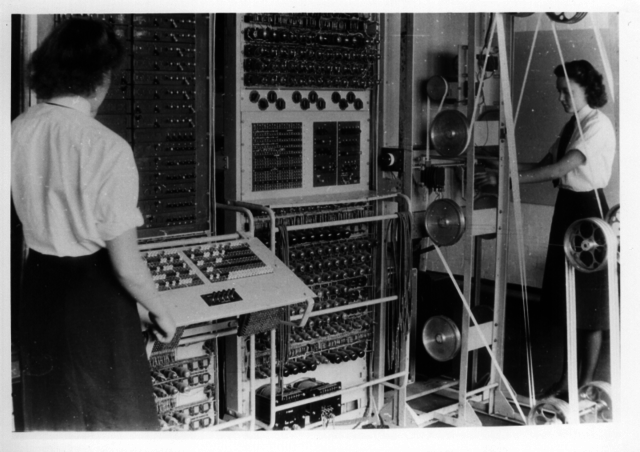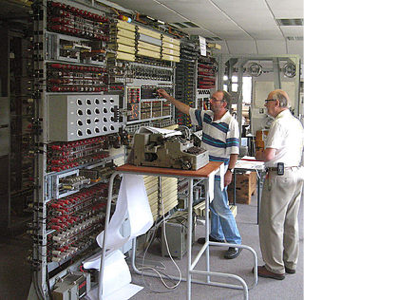
These computers were built and designed in the most efficient way that they could easily perform the Boolean calculations. The greater amount of the electronic valves in the Mark 2 was the reason behind the fast speed of the Mark 2 (Reed 2007).Ĭolossus computers were efficient because these machines were the first to use shift registers and counters. The evident difference between the Mark 1 and Mark 2 was that there were 1,500 electronic valves in the Mark 1 and 2,500 electronic valves in the Mark 2. After the Colossus Mark 1 there were further Colossi which were used by the end of the Second World War. After the procedure of the testing of the machine, this machine was sent to Bletchley Park and processed the first message for the first time on 18th January 1944. It took eleven months for Tommy Flowers to design and build the colossus computers in the research station in London. The third step undergoes if the match count of the settings is higher than their constant of the threshold, it would be sent to the electronic typewriter device as the output of the process.In the second step an electronic simulation of Lorenz machine that is a stream is processed.These coded messages were read from a paper tape at a higher rate of speed.

The process of reading these messages included three steps as follows:
#COLOSSUS COMPUTER CODE#
An interesting point to note here is that British code breakers used to call these encrypted messages as Fish. That is why Turing called the machine universal.The Colossus computers were highly secret machines for a specific purpose of cracking the messages which were encrypted with the help of Lorenz sZ40/42 machine. By inserting different programs into the memory, the machine can be made to carry out any algorithmic task. (For a description of the decision problem and Turing’s approach to it, see ‘Computable Numbers: A Guide’ in The Essential Turing.115) In the course of his attack on this problem, Turing thought up an abstract digital computing machine which, as he said, could compute ‘all numbers which could naturally be regarded as computable’.116 The universal Turing machine consists of a limitless memory in which both data and instructions are stored, in symbolically encoded form, and a scanner that moves back and forth through the memory, symbol by symbol, reading what it finds and writing further symbols. Turing was working on a problem in mathematical logic, the so-called ‘decision problem’, which he learned of from lectures given by Newman. His ‘universal computing machine’, as he called it-it would soon be known simply as the universal Turing machine-emerged from research that no-one would have guessed could have any practical application.

At the time, Turing was a shy, eccentric student at Cambridge University. This basic principle of the modern computer, that is, controlling the machine’s operations by means of a program of coded instructions stored in the computer’s memory, was thought of by Turing in 1936. The process was a nightmare: it could take the ENIAC’s operators up to three weeks to set up and debug a program.114 Colossus, ENIAC, and their like are called ‘program-controlled’ computers, in order to distinguish them from the modern ‘stored-program’ computer. The larger ENIAC was also programmed by re-routing cables and setting switches. To set up Colossus for a different job, it was necessary to modify some of the machine’s wiring by hand, using switches and plugs. Colossus did not store programs in its memory. (Flowers’ original plan was to dispense with the message tape as well and set up the ciphertext, as well as the wheels, on valves but he abandoned this idea when it became clear that messages of 5000 or more characters would have to be processed.57)Īs everyone who can operate a personal computer knows, the way to make the machine perform the task you want-word-processing, say-is to open the appropriate program stored in the computer’s memory. Only one tape was required, containing the ciphertext-the synchronisation problem vanished. Colossus generated the chi-stream electronically. This boosted the speed to 25,000 characters per second.

Later models, containing approximately 2400 valves, processed five streams of dot-and-cross simultaneously, in parallel. The prototype Colossus was brought to Bletchley Park in lorries and reassembled by Flowers’ engineers.56 It had approximately 1600 electronic valves and operated at 5000 characters per second. From 1941 Hitler and the German High Command relied increasingly on Tunny to protect their communications with Army Group commanders across Europe. Technologically more sophisticated than Enigma, Tunny carried the highest grade of intelligence.

Colossus, the first large-scale electronic computer, was used against the German system of teleprinter encryption known at Bletchley Park as ‘Tunny’.


 0 kommentar(er)
0 kommentar(er)
